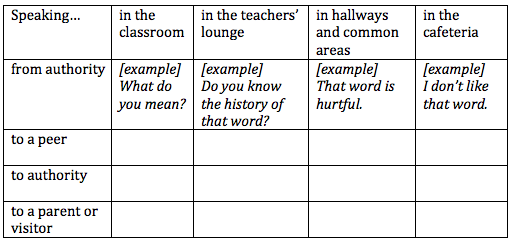How to Implement 'Speak Up At School'
Section 1: In Advance
Read “In Advance” (pgs. 8-15 in Speak Up At School)
After reading, respond to the following:
- Name examples of biased language you hear at your school.
- What words have become colloquial yet are still harmful, biased language?
- Do your students understand intent vs. impact?
- What are you currently doing or what have you done in the past to establish a safe environment where all students can learn?
![]() In groups of 3-4, round robin share your answers and address the following question as a group: What words do we pledge to not accept as part of our school’s environment?
In groups of 3-4, round robin share your answers and address the following question as a group: What words do we pledge to not accept as part of our school’s environment?
How will you and your students prepare to speak up?
![]() Think/Pair/Share. Think: how will you and your students prepare to speak up? Pair: turn to the person next to you. Share: fill in the chart.
Think/Pair/Share. Think: how will you and your students prepare to speak up? Pair: turn to the person next to you. Share: fill in the chart.

Stop and Think
Before moving on to the next section, write down strategies you use to speak up against bias, prejudice and stereotypes.
Section 2: In the Moment
![]() Form groups of 3-4 and read “Basic Strategies” together. Stop after each section and fill in “Things I Can Say” in the chart below. Record ideas on chart paper visible to the whole group.
Form groups of 3-4 and read “Basic Strategies” together. Stop after each section and fill in “Things I Can Say” in the chart below. Record ideas on chart paper visible to the whole group.
Read “Basic Strategies” (pgs. 18-23 in Speak Up At School) and add to the “Things You Can Say” column in the chart below any additional responses you or your students use. The pocket guide and Appendix A of Speak Up At School summarize strategies for speaking up against biased language in easy to reference locations.

Stop, Watch, Create:
Speak Up At School pocket guide video
Print and make your own pocket guide.
Stop and Think:
What is hard about speaking up against intolerance in a timely manner?
How do these strategies help?
The Dynamic and The Location (pgs. 24-41) address the particulars of speaking up against biased language, prejudice and stereotypes. Your relationship with the person using biased language and the location of the situation make a difference in how comfortable and confident you feel speaking up, especially in a timely manner. As you read, use your pocket guide to plan out and prepare how you will speak up against biased language.

Stop and Think
How does the pocket guide help you speak up against biased language, prejudice and stereotypes at school?
How does the pocket guide help your students speak up against biased language, prejudice and stereotypes at school?
![]() Pair and share your thoughts.
Pair and share your thoughts.
Section 4: Putting It All Together
We must work together to guarantee a school free of biased language, prejudice and stereotypes. “Putting It All Together” (pgs. 44-45 in Speak Up at School) summarizes how educators can prepare themselves to challenge bias and prejudice in schools by identifying the basics: be prepared, be positive, be confident, be encouraging and work together. Continue to the next section to give it a try.
Section 5: Role-Playing
![]() If working in groups, allow 2-3 minutes for discussion after each video.
If working in groups, allow 2-3 minutes for discussion after each video.
Watch and respond to the following:
How can you make it clear that you are attentive to the needs of the child and also appeal to the parent’s sense of fairness?
Watch and respond to the following:
What does the student understand about stereotypes and privilege? What do those who were laughing understand about stereotypes and privilege?
Watch and respond to the following:
What might the principal in this case do? What might an individual teacher do or say?
Watch and respond to the following:
How would you advise the girl to respond? What else can you do?
Watch and respond to the following:
What was this student trying to convey to his female classmate? Is there another way to say it?
Watch and respond to the following:
How might the targeted student have felt when this comment was made?
Watch and respond to the following:
Does the context and significance of the comment change if this teacher is from a background similar to the student? Does the significance change if a student makes the comment?
Conclusion:
When we started this series of activities, you were asked to think about biased language in your school. Now you have tools to speak up against biased language, prejudice and stereotype.
As a final exercise, think about an actual situation or remark you have experienced at school.
Plan how you will respond differently, using the strategies outlined in your pocket guide, from how you may have responded during the situation.
How will you respond the next time you hear biased language?